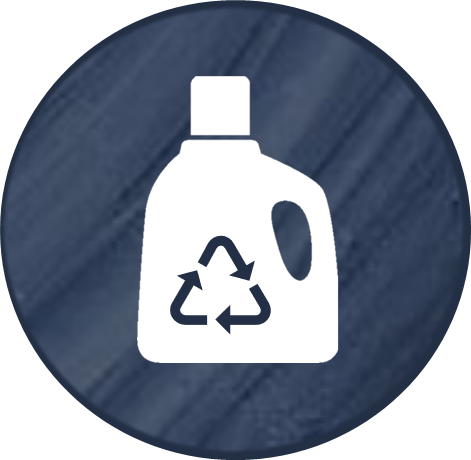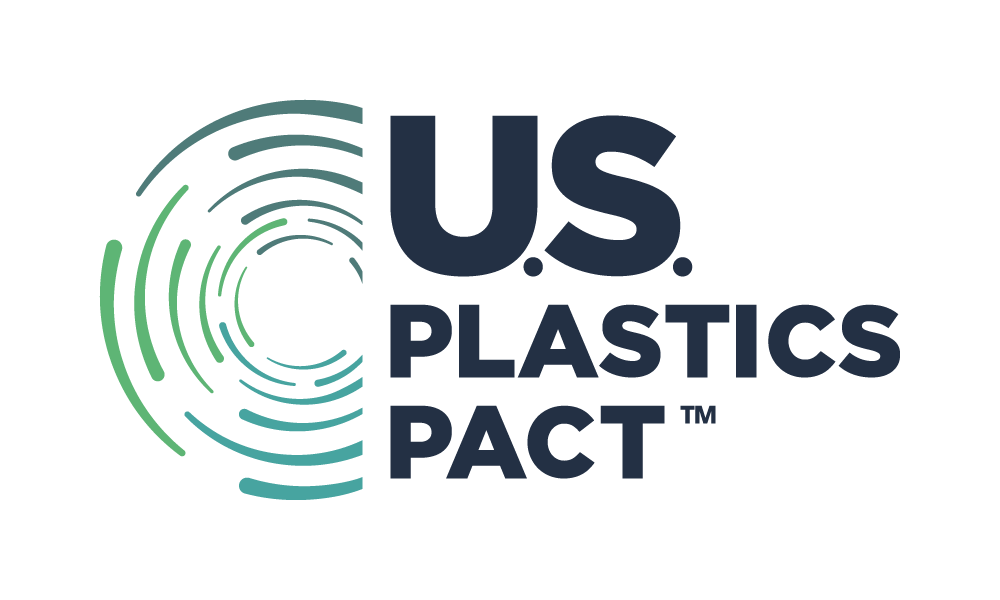Explore the drop-down menu below to learn more about why postconsumer recycled content (PCR) is an essential part of a circular economy and reasons packaging designers are using more of it.
INTRINSIC / SOLVING SUSTAINABILITY OBJECTIVES
Using PCR in packaging is essential to driving the circular economy. There are a tremendous number of voluntary brand commitments, including the U.S. Pact which encourage the use of postconsumer resin to reduce overall carbon footprint. PCR certification provides the metrics and verification to establish credibility. This leads to better customer relations and retention.
Driving Entity: Brands
PCR BRAND EQUITY
Increased perceived value is a consideration paid to justify fair material costs. This is important as many prime PCR grades can result in higher pricing than virgin resin. Additionally, PCR is process intensive as compared to virgin resin. It’s easier to use virgin resin or postindustrial resin (PIR), which processes like virgin resin. U.S. Pact Activators should be able to market their material fairly to a market that requires validation of PCR use. The only way to do that is to prove they are using actual PCR.
Driving Entities: Recyclers & Converters
REGULATORY COMPLIANCE & INCENTIVE
Several states and local governments have rules and regulations surrounding packaging and recycled content in products. By offering a more sustainable option, PCR enables regulatory compliance, and in some cases like CA, using certified PCR is an incentive towards lower eco-modulation fees.
Driving Entities: Brands, Converters, & Recyclers
BEING PROACTIVE
Limiting some of the negative impacts of plastics can help to counteract the negative perception of plastics in advance of additional regulation. PCR reduces the need to create new plastics from non-renewable petroleum products. This changes the game. Plastics become a resource instead of waste.
Driving Entities: Brands, Converters, & Recyclers

Manufacturing products with recycled plastics means BIG energy savings. PCR reduces energy consumption by at least 79% and reduces GHG emissions by at least 67%.

Manufacturing products from recycled PET, HDPE, and PP saves more electricity than is consumed annually in all of Los Angeles.

Manufacturing products from recycled PET, HDPE, and PP reduces GHG emissions the same amount as taking nearly half a million cars off the road.

Recycling material into new products we can use again reduces the amount of material heading to landfills. This in turn reduces littering and marine debris.
Learn More from APRConsumer Acceptance & Perceptions of PCR
Key Points on Public Perceptions of PCR
McKinsey & Company – Sustainability in packaging: Inside the minds of US consumers
- 55% of U.S. survey respondents report that they are extremely or very concerned about the environmental impact of product packaging.
- 38% of U.S. consumers say that the importance of sustainable packaging when they purchase products for various end-use areas is extremely or very important.
- Across all end-use segments, 60-70% of consumers said they would pay more for sustainable packaging. A willingness to pay more was relatively equally distributed across end-use segments.
- 52% of consumers said they would buy more products with sustainable packaging if those products didn’t cost more than conventionally packaged ones.
- Approximately 35-36% of respondents would buy additional sustainably packaged products if they were more available in stores, available for more products, and better labeled (to indicated green packaging).
- Overall, consumers want plastic film and rigid packaging to be recyclable or to include higher levels of recycled content.
The Recycling Partnership – Recycling Confidence Index
- 52% believe that recycled items are “made into new things.” 40% believe that material is “sometimes” used, 36% believe that material is “usually” used, and 16% believe material is “always” used.
Shelton Group – Old Dogs, New Tricks
- 65% of U.S. consumers surveyed indicated they feel very concerned or extremely concerned about plastic in the ocean compared to 58% who had similar feelings towards climate change.
- 42% of those polled want to be seen as someone who’s buying eco-friendly products.
U.S. Pact’s PCR Commitment Statement
Postconsumer recycled content (PCR) or responsibly sourced biobased content use is one of the critical paths to reduce the environmental impact of plastic products and achieve a circular economy in the plastics packaging industry. The U.S. Plastics Pact (U.S. Pact) abides by the ISO definition for PCR, which states that PCR is, “material generated by households or by commercial, industrial, and institutional facilities in their role as end-users of the product, which can no longer be used for its intended purpose. This includes returns of material from the distribution chain.”
The U.S. Pact has voluntary PCR usage requirements for all its Activators based on their place in the plastics value chain, with the goal of creating momentum to reach Target 4 of the U.S. Plastics Pact Roadmap of an average of 30% (by weight) postconsumer recycled content in plastic packaging sold within the United States by 2025. The U.S. Pact expects that Activators who already have a publicly stated general recycled content commitment specifically call out PCR commitments instead of or in addition to using the term “recycled content.” For U.S. Pact Activators who produce and distribute plastic packaging, such as consumer product goods companies (CPGs), retailers, and converters, we expect each to publicly state a commitment to a quantifiable target of PCR that is incorporated into their plastic packaging by 2025. For Activators that are non-plastic packaging producers, such as government entities, nonprofit organizations, and recyclers, we expect that each Activator publish external statements on quantifiable internal PCR procurement. PCR internal procurement includes, but is not limited to, office supplies, trash bags, pallets or bins/totes, and trash and recycling bins. The U.S. Pact also encourages non-packaging Activators to have a public statement supporting the use of PCR to address PCR markets on a larger scale, closing this loop of the circular economy.
PIR Statement
Out of Scope for U.S. Pact Measurement
Post-industrial recycled (PIR) materials divert waste from the landfill and reduce the need for virgin plastic. The U.S. Pact, as a standard operating procedure, recommends that Activators utilize PIR in their products and procurements. The ISO definition for PIR is, “pre-consumer…a material diverted from the waste stream during a manufacturing process. Excluded is reutilization of materials such as rework, regrind or scrap generated in a process and capable of being reclaimed with the same process that generated it.” However, the U.S. Pact does not allow PIR commitments or use to replace PCR commitments as part of the U.S. Pact’s four targets. The U.S. Pact recognizes that there is more work to be done to create markets for PCR than there is for PIR, and as such PCR commitments are the priority.
Examples of Postconsumer & Post-Industrial Materials
Below are examples of PCR and PIR. PIR is out of scope for the U.S. Pact. The differences between PIR and PCR are nuanced, and it is important to identify real-world applications of both.
Postconsumer materials based on the ISO definition:
- A consumer purchases a bottle of soda, drinks it, and places it in a recycling bin.
- A pallet of laundry detergent ships from the producer to the retailer. The retailer discovers that a bottle has leaked laundry detergent all over the rest of the bottles. The bottles are emptied and sent to a recycler.
- Stretch wrap is used to transport a pallet from the producer to a retailer. The retailer cuts off the stretch wrap and sends it to a recycler.
Post-industrial materials based on the ISO definition:
- A mask manufacturer purchases roll stock and trims it into individual masks. The trimmings are sent to a recycler.
- 4 truckloads of jars arrive at a manufacturing facility and are warped and unusable. They are sent to a recycling facility.
PCR Legislation & Regulation
State Legislation
Other Resources
- Duke University‘s Global, Searchable Plastics Policy Inventory
- Ocean Conservancy Policy
- SPC’s Guide to EPR Proposals – Where PCR could contribute to eco-modulation
- WasteDive Recycling Policy Tracker
Resources Requiring Memberships

PCR Toolkit Homepage
- PCR Toolkit Introduction
- U.S. Pact Background
- PCR Defined
- U.S. Pact Testimonials

Purchasing PCR
- Finding a PCR Supplier
- Pricing Models for PCR
- Factors that Impact PCR Price
- Contract Considerations
- Purchasing Direct from PCR Supplier or Through a Plastic Converter

Integrating PCR
- Quality Considerations
- FDA requirements
- Converter preparation
- On-pack labeling
- Certification Position Statement

Join the U.S. Pact
PCR use is critical to achieving a circular economy in the plastics industry. Please contact us about joining the U.S. Pact if your organization is committed to keeping plastic in the economy and out of the environment.
CONTACT USDisclaimer
The U.S. Plastic Pact created this toolkit to assist U.S. Pact Activators in voluntarily purchasing postconsumer resin for their products and packaging. This toolkit does not contain any endorsements, recommendations, legal or financial advice, and should not be construed as such. The U.S. Pact and contributing authors are not liable for any business decisions that result from consulting this toolkit.
